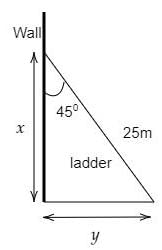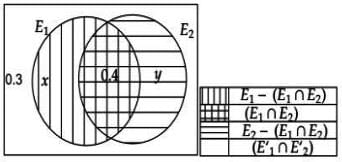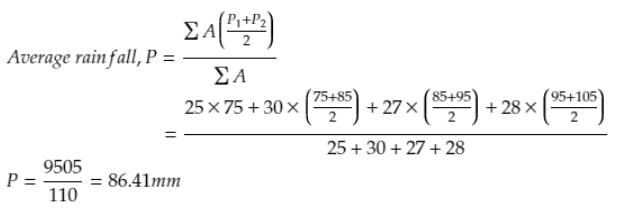GATE Environmental Science Mock Test - 6 - GATE Environmental Science MCQ
30 Questions MCQ Test - GATE Environmental Science Mock Test - 6
A 25m long ladder (whose foot is on the ground) leans against the wall making an angle of 450 with the wall. What is the ratio of the horizontal distance of the wall and foot of the ladder to the height of the point where the ladder touches the wall from the ground?
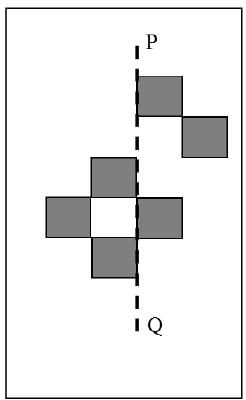
The least number of squares that must be added so that the line P-Q becomes the line of symmetry is ________

The least number of squares that must be added so that the line P-Q becomes the line of symmetry is ________
Nostalgia is to anticipation as _______ is to ________
Which one of the following options maintains a similar logical relation in the above sentence?
Corners are cut from an equilateral triangle to produce a regular convex hexagon as shown in the figure below.
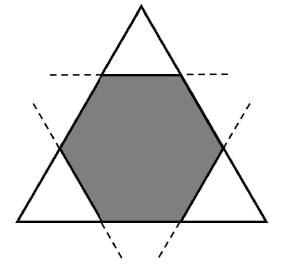
The ratio of the area of the regular convex hexagon to the area of the original equilateral triangle is
In a clariflocculator which of the following unit operations take place?
1. Coagulation
2. Aeration
3. Filtration
4. Sedimentation
What is the pH of a water sample having H+ concentration of 10 mg/L? The atomic weight of H is 1 g/mol.
CRZ notification of Government of India specifies the stretches of sea, bays, estuaries etc as coastal areas require protection from developmental activities.
The correct ascending order of the following greenhouse gases with respect to their global warming potential relative to CO2 in the time horizon of 100 years is
Read the following statements with reference to the Kyoto Protocol on Climate Change
i) Each signatory (country) has common and equal responsibility.
ii) Clean development mechanism (CDM), joint implementation (JI) and international emission trading are the three mechanisms under Kyoto Protocol to reduce the greenhouse gas emissions.
iii) Under Kyoto Protocol, India has agreed to reduce its greenhouse gas emissions by half by 2050 as compared to 2005 emissions.
Which one of the following is correct choice?
Read the following statements
I. In environmental laws, the polluter pays principle is enacted to make the polluter responsible for paying for the damage done to the natural environment.
II. The precautionary principle emphasizes caution, pausing and review before going for an innovation that may prove disastrous.
III. The precautionary principle is often used by policy makers in situations where there is the possibility of harm from making a certain decision and conclusive evidence is not yet available.
The correct choice is
(MSQ-This is a multiple select question, one or more than one option can be correct)
Which of the following options regarding evaporation from lakes is/are incorrect?
In a sample, the growth of microbial cells started with an initial concentration of 5 × 104 cells per millilitre (mL) of the sample. After a certain time period, the cell concentration was found to be 1280 × 104 cells per mL of the sample. Assuming binary fission of cells and no cell death, the number of generations of cell growth occurred in this time period is ____________ (answer in integer).
If for two events E1 and E2, P( E1 ∩ E2 ) = 0.4 and P ( E1c ∩ E2c ) = 0.3 and P(E1) = P(E2). Then P(E1) will be ___.
(Write your answer rounding off to 2 decimals)
A researcher compiled the following information about the performance of a kit in an outbreak

The probability of detecting an infection for a positive result through the kit would be ________ (rounded off to three decimal places).
Calculate the ultimate BOD of the sample (in mg/l) when the initial DO of the sample(5 ml) and distilled water(295 ml) is 1 mg/l and 8 mg/l respectively. The final DO of the mixture after 5 days is 4 mg/l. Assume k(base e) = 0.23 day-1
For a fluid flow occurring at a point P, the pressure is observed as 100 kPa when the fluid is flowing with a speed of 50 m/s.What is the stagnation pressure observed at P in kPa?
Density of fluid = 1000 kg/m3
An ideal PFR or an ideal CFSTR may be used to degrade a pollutant with first order reaction kinetics. Both the reactors are fed with the same inlet concentration and the same volumetric flow rate, and are designed to achieve the same outlet concentration. Which of the following statements is true when comparing PFR with CFSTR?
PFR is Plug Flow Reactor.
CFSTR is Continuous Flow Stirred Tank Reactor (also referred to as CSTR).
A sewage treatment plant (STP) receives sewage at a flow rate of 20000 m3 per day. The sewage has 200 mg/L of suspended solids. Assume 60 % suspended solids are removed in the primary clarifier. The underflow (i.e. sludge) removed from the clarifier contains 5 % solids (by weight).
The daily volume of the sludge generated will be ____________ m3 per day. Assume sludge density = 1000 kg/m3.
Which one of the following statements is NOT correct?
Read the following statements
I. Bacteriophage is an anaerobic bacterium.
II. Male-specific bacteriophage infect via the pili of other microorganisms including viruses.
III. Bacteriophage is found in human as well as in animal excreta.
IV. Bacteriophage can not indicate the presence of bacteria.
The correct choice is
Which of the following is/are correct for the process of glycolysis?
A mechanized stationary container system is proposed for waste collection from a commercial area. The container unloading time is 0.1 hours per container. There are two containers at each location and the drive time between the two locations is 0.2 hours. The maximum waste ‘pick-up time’ is 2.4 hours per trip.
The ‘pick-up time’ starts at the instant the truck arrives at the first pick-up location and ends when the last container on the route is emptied. The maximum number of locations which can be covered in a trip by the collection vehicle are ____________ (answer in integer).
The following figure (not to the scale) shows a catchment (Q, S, U, T, Q) and adjoining raingauge stations P, Q, R, S, U and V. Due to a storm, 20 mm, 25 mm, 30 mm, 15 mm, 22 mm and 18 mm rainfall depths were recorded by raingauges at P, Q, R, S, U and V, respectively.
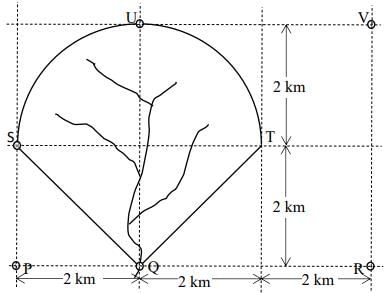
The corresponding mean rainfall over the catchment using Thiessen polygon method is __________ (in mm, rounded off to two decimal places).
A plunger weighing 314 kN is balanced in a cylindrical vessel of diameter 1.5 m and filled with an oil (specific gravity 0.9) as shown in the following figure (not to the scale).
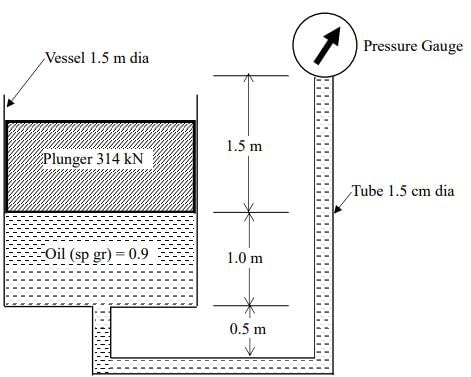
If a pressure gauge is connected with the vessel using 1.5 cm diameter tube, the reading of the gauge will be _______ (in kPa, rounded off to two decimal places).
A fully penetrating well is installed in a homogenous and isotropic confined aquifer. The aquifer has uniform thickness of 16 m and hydraulic conductivity of 25 m/d. Water is being pumped out from the well at a constant rate of 0.1 m3/s till steady state condition is reached. If a drawdown of 3.5 m is observed at a distance of 75 m from the well then the drawdown at a distance of 150 m from the well will be ________ (in m, rounded off to two decimal places).
An analysis of rainfall in an area using the isohyetal method, the following data is observed. Calculate the average rainfall recorded(in mm, up to 2 decimal places) in the region.
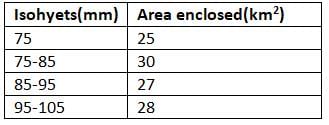
A 10 million litres per day (MLD) sewage treatment plant (STP) is based on the Activated Sludge Process (ASP). First, the sewage undergoes primary treatment and the resulting treated sewage has BOD5 of 140 mg/L concentration. This is further passed through a 1500 m3 capacity aeration tank (in ASP), where the mixed liquor volatile suspended solids (MLVSS) concentration is maintained at 3000 mg/L. The concentration of BOD5 of the treated sewage is 5 mg/L.
The Food to Microorganisms ratio (F/M) of the ASP is ____________ day-1 (rounded off to two decimal places).
The molar concentrations (M, i.e. mol/L) of some ionic species in a water sample were estimated as follows:
Na+ = 0.25 M; Ca2+ = 0.12 M; CI- = 0.32 M; HCO-3 = 0.05 M.
The ionic strength of this water sample is ____________ M (correct up to two decimal places).
Excess amount of solid calcium sulphate (CaSO4) was added to a pure water sample (pH = 7) so that some solids remain undissolved at the equilibrium. The solubility product of CaSO4 is 2x10-5 mol2/L2. The molar concentration of SO2-4 in this water sample at mol/L (rounded off to three equilibrium will be decimal places).


